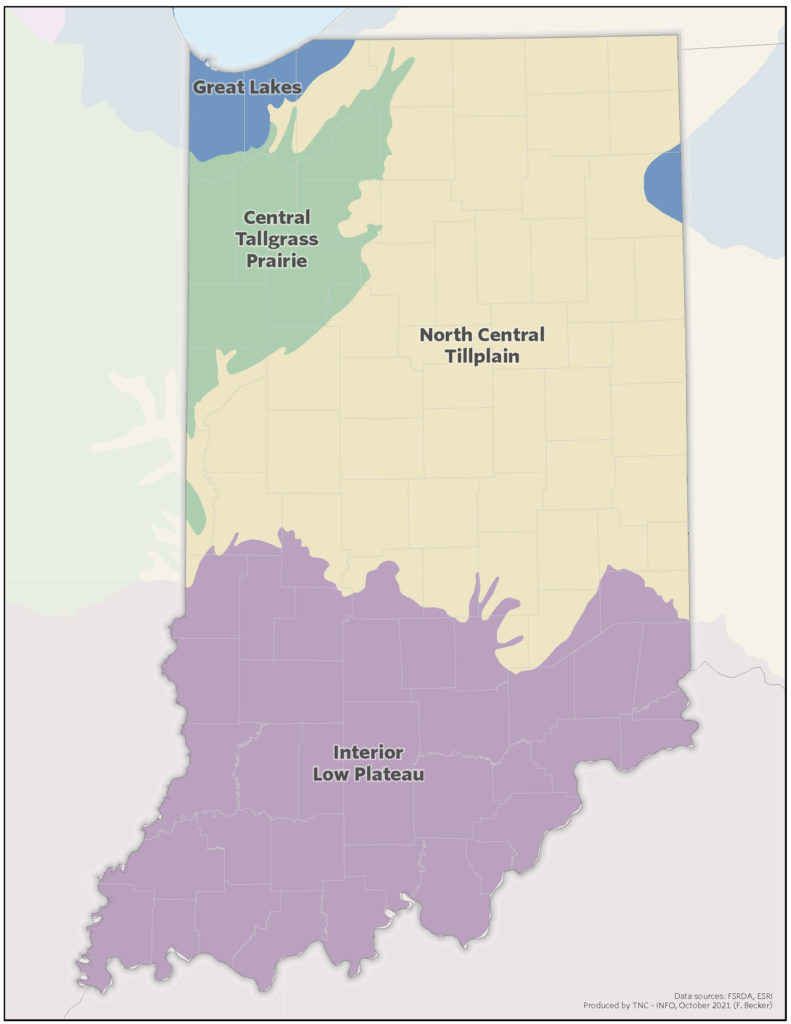A statewide project of the Indiana Native Plant Society, Indiana Native Seed Communities promotes networks of native plant enthusiasts working together regionally to procure, prepare, and propagate native plant seeds. Our aim is to increase the presence of ecologically appropriate native plants in all landscapes.
Personal and institutional knowledge regarding how to procure, process, and propagate native seeds is very limited. By increasing programs, resources, and support, we are creating communities of knowledgeable amateurs and professionals and inspiring them to free up and prepare land for rewilding with responsibly procured, prepared, and propagated native plants from seeds.
We envision these communities actively participating in expanding native plant populations in all landscape settings to help create and restore diverse, plant-rich habitats, support biodiversity, and mitigate the impacts of climate change.
Expanding Access to Seed-Grown Indiana Natives
Our key objective is to expand access to and use of seed-grown Indiana native plants! To accomplish this, we work to:
- Instill a sense of urgency in the need to expand native plant populations in all landscape settings to help address biodiversity loss and climate change.
- Expand NSC’s impact in Indiana and present it as a model for organizations in other geographic regions.
- Demystify growing native plants from seed, thus encouraging more people to sow Indiana native seeds.
- Provide information and guidance on how to free up and prepare land for rewilding.
- Develop groups of trained volunteers working together to procure, process, and propagate seeds and plants native to Indiana to share within their communities.
- Support Indiana Plant Conservation Alliance.
- Facilitate and encourage native plant seed swaps.
- Enable members’ seed-grown plants to be shared with friends, sold for fundraisers, or donated to public gardens, preservation projects, etc.
A Chapter-Based Program
An Indiana Native Seed Community is a group of individuals within an INPS Chapter’s region who are interested in learning about, advocating, and growing native plants from seed. The Community provides regional/local support, hands-on training, and networking opportunities; sponsors regional/local workshops and field visits in coordination with the INPS Chapter; and leads special projects.
Although we encourage the propagation of all regionally appropriate native seeds, the program encourages collecting and propagating that specific region’s seed.
A Network of Affiliates
As the sponsor of Indiana Native Seed Communities, the Indiana Native Plant Society offers support to all active, chapter-based Communities throughout the state. Although INPS chapters are the focus, any like-minded Indiana group is welcome to be a part of the program as an affiliate, creating the Indiana Native Seed Communities Network. Examples of Network affiliates include Soil and Water Conservation Districts, neighborhood homeowner associations, garden clubs, Cooperative Invasive Species Management Area (CISMA) coalitions, green sanctuary initiatives, community gardens, and local parks and recreation areas. Affiliates will work closely with their region’s INPS chapter.
The Network provides statewide programs, resources, and support via the INPS website, online webinars, a dedicated Facebook group, and targeted communications. Leadership is provided by a program leader, with guidance from a formal steering committee and ad hoc advisors and trainers.
Elements of a Thriving Native Seed Community
- Seed collection opportunities and how-to instruction (especially regional provenance)
- Seed access through sharing events, such as seed swaps/exchanges and seed libraries
- Regional seed banking
- Instruction on autumn & winter sowing and/or fridge/outdoor stratification, including specific species germination guidance
- Instruction on handling seed-propagated seedlings
- Local access to plants propagated from seed (especially from regional provenance seed)
- Active community restoration efforts using locally produced seeds and plants, such as through a regional land trust or city parks and recreation department.
- Regional efforts at encouraging and supporting seed increase plots through organic/regenerative agriculture.
Focus on Plants Native to Indiana
Recent studies have shown that as many as 40% of plant species are threatened with extinction, and animals that directly depend on native plants (such as insects and birds) are seeing high rates of decline. Even our “common” plant species are seeing severe reductions. Meanwhile, the marketing and selling of “pretty and/or better behaved” cultivars in the retail trade—though they may be more ecologically supportive than non-native plants—contributes to a decrease in genetic diversity.
Plants grown from the seeds of plants native to Indiana:
- Provide unparalleled resources for all sorts of life forms—mammals, birds, insects, fungi, and other plants throughout their lifecycle.
- Provide genetic variation—a species’ best strategy for adapting to future environmental conditions—and maintain the genetic diversity inherent in wild native plants.
- Have low resource requirements for water, fertilizer, and pesticides.
- Provide greater resiliency and are best suited for the soil and weather conditions in our area.
- Help prevent the spread of non-native, invasive plants.
- Planted in the right habitat, are easy to grow from seed and can be grown inexpensively, with a little guidance and support.
- Are beautiful and come in a variety of colors, shapes, sizes, and species.
- When you grow them yourself, you gain access to a lot more plants and at a much lower cost.
Guiding Principles
Indiana Native Seed Communities work together to Procure, process, and propagate plant seeds native to Indiana, enabling a greater variety and number of seeds and plants to be grown by and shared among members, thus increasing the presence of native plants in all our landscapes.
Mindful of the need to protect our remnant native plant populations, participants must adhere to these guidelines:
- All native seed collected shall come from native gardens or from private lands with owner permission.
- When wild collecting seed, collect no more than 5% of seeds from an individual plant and 5% of the whole population.
- If collecting in a garden or prairie planting, the 5% rule may not be as critical, but even in this situation, consider the importance of letting some of the seed fall. This is especially important in prairie plantings, for they depend not only on the living plants but also on the “seed rain” that ripens and falls to the ground each year. Over-harvesting may disrupt the seed rain and over time impact the overall vitality of a natural space.
- It is NOT PERMITTED to collect in national or state parks or in conservation lands.
- Absolutely no collecting seed of rare, endangered, or threatened species unless participating in an Indiana Native Plant Society approved program such as Indiana Plant Conservation Alliance.
- Provenance of seeds should be closely tracked regionally.
- Neonicotinoids and other nonorganic pesticides or fungicides or growth regulators shall not be used in Community-grown seeds or plants. This restriction does not apply to the use of herbicide as a tool for site prep and maintenance to control invasive and/or non-desirable vegetation, especially for larger scale native planting areas.
- The Nature Conservancy map of Indiana’s ecoregions (see below) shall be used as the framework for determining provenance boundaries for the collecting and propagating of Indiana ecotypes. According to the map, Indiana includes four ecoregions: Great Lakes, Central Tallgrass Prairie, North Central Tillplain, and Interior Low Plateau.
- Target keystone* and high value, pollinator forage species that have healthy ecoregional populations, are horticulturally adaptable and readily available in the nursery trade.
- Participants should strive to use fewer plastics (e.g., use wooden flats/trays, clay pots). At a minimum, for plant sales, implement a pot recycling program.
*Species of plants that have a “disproportionately large effect on the abundance and diversity of other species in an ecosystem.” Example: goldenrod species, which support 112 native caterpillar species (Douglas Tallamy, Nature’s Best Hope, p. 139).
Indiana’s Four Ecoregions (from The Nature Conservancy)
Want To Help Restore Native Habitats?
If so, we invite you to consider growing some Indiana native plants from seeds collected through our Native Seed Communities project on your own property. Perhaps you have an area of your garden that you can dedicate to these precious plants, or you’re an organic gardener interested in growing a pollinator strip to attract pollinators. Such plantings will contribute to the ecological health of your own property while offering a future seed source to contribute to the expansion of available seeds of local provenance. If interested, contact Bill Daniels, Indiana Native Seed Communities Program Leader, at seed@indiananativeplants.org.




